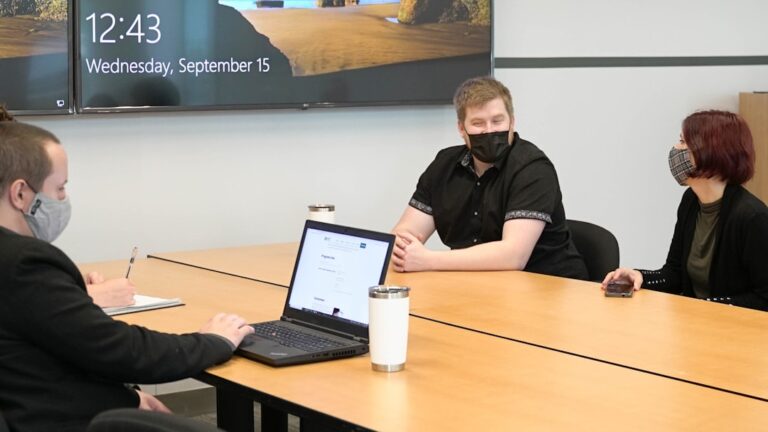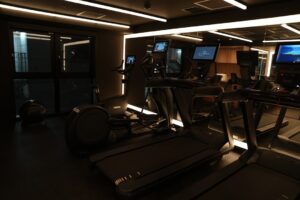Prolonged sitting has emerged as a significant health concern in modern society, particularly as many jobs require individuals to remain seated for extended periods. Research has shown that sedentary behavior is linked to a myriad of health issues, including obesity, cardiovascular disease, and even certain types of cancer. The World Health Organization has classified physical inactivity as one of the leading risk factors for global mortality.
When individuals sit for long durations, their metabolism slows down, which can lead to weight gain and increased fat accumulation around the abdomen. This accumulation is particularly concerning as it is associated with a higher risk of developing type 2 diabetes and heart disease. Moreover, prolonged sitting can have detrimental effects on musculoskeletal health.
Sitting for extended periods can lead to poor posture, which places undue stress on the spine and surrounding muscles. This can result in chronic back pain, neck strain, and other musculoskeletal disorders. A study published in the journal “Annals of Internal Medicine” found that prolonged sitting is associated with an increased risk of early death, regardless of physical activity levels.
This highlights the importance of not only engaging in regular exercise but also minimizing the time spent sitting each day. The cumulative effects of a sedentary lifestyle can be profound, making it essential for individuals to recognize the risks associated with prolonged sitting and take proactive steps to mitigate them.
Desk Exercises to Incorporate into Your Daily Routine
Incorporating desk exercises into your daily routine can significantly counteract the negative effects of prolonged sitting. Simple movements can be performed throughout the day without requiring extensive time or space. For instance, seated leg lifts are an excellent way to engage the lower body while remaining at your desk.
To perform this exercise, sit up straight in your chair and extend one leg out in front of you, holding it parallel to the ground for a few seconds before lowering it back down. Repeat this with the other leg. This exercise not only strengthens the quadriceps but also promotes blood circulation in the legs.
Another effective desk exercise is the seated torso twist. This movement helps improve spinal mobility and can alleviate tension in the back and shoulders. To perform a seated torso twist, sit upright in your chair with your feet flat on the floor.
Place your right hand on the back of your chair and gently twist your torso to the right while keeping your hips facing forward. Hold this position for a few seconds before returning to the center and repeating on the left side. Incorporating these simple exercises into your workday can help break up long periods of sitting and promote overall physical well-being.
Tips for Proper Posture at Your Desk

Maintaining proper posture at your desk is crucial for preventing discomfort and long-term musculoskeletal issues. One of the fundamental aspects of good posture is ensuring that your chair supports your lower back adequately. An ergonomic chair should allow you to sit with your feet flat on the floor, knees at a 90-degree angle, and thighs parallel to the ground.
If your chair does not provide adequate support, consider using a lumbar roll or cushion to maintain the natural curve of your spine. Additionally, the positioning of your computer screen plays a vital role in promoting good posture. The top of your monitor should be at or just below eye level, allowing you to look straight ahead without straining your neck.
Your screen should be about an arm’s length away from you to reduce eye strain. Furthermore, it’s essential to keep your wrists straight while typing; using a wrist rest can help maintain this alignment and prevent repetitive strain injuries such as carpal tunnel syndrome. By being mindful of these posture tips, you can create a more comfortable workspace that supports your health.
The Importance of Taking Regular Breaks
| Benefits of Taking Regular Breaks | Statistics |
|---|---|
| Improved productivity | 86% of employees say that taking regular breaks helps them be more productive |
| Reduced stress | 75% of workers report feeling less stressed after taking regular breaks |
| Enhanced creativity | 68% of employees believe that taking breaks boosts their creativity |
| Healthier work-life balance | 90% of workers feel that taking regular breaks helps them maintain a healthier work-life balance |
Taking regular breaks throughout the workday is essential for maintaining both physical and mental well-being. Research indicates that short breaks can enhance productivity, creativity, and focus. When individuals work for extended periods without interruption, they may experience fatigue and diminished cognitive function.
By stepping away from their desks periodically, employees can recharge their minds and bodies, leading to improved performance upon returning to their tasks. Incorporating breaks into your routine doesn’t have to be complicated; even a few minutes away from your desk can make a significant difference. For example, consider setting a timer to remind yourself to take a five-minute break every hour.
During this time, stand up, stretch, or take a brief walk around the office or outside if possible. Engaging in light physical activity during breaks can stimulate blood flow and reduce feelings of lethargy associated with prolonged sitting. Additionally, these breaks provide an opportunity to clear your mind and refocus, ultimately contributing to a more productive workday.
Ergonomic Desk Set-Up for Better Comfort and Health
Creating an ergonomic desk setup is fundamental for promoting comfort and health while working at a desk. An ergonomic workspace is designed to minimize strain on the body and enhance productivity by ensuring that all elements are positioned correctly. Start by adjusting your chair height so that your feet rest flat on the floor or on a footrest, with your knees aligned with or slightly lower than your hips.
This position helps maintain proper spinal alignment and reduces pressure on the lower back. The arrangement of your keyboard and mouse is equally important in an ergonomic setup. Your keyboard should be positioned so that your elbows are at a 90-degree angle when typing, with your wrists straight and hands hovering just above the keys.
A separate mouse can help maintain this alignment while allowing for more natural wrist movement compared to using a laptop trackpad. Additionally, consider using an adjustable monitor stand or arm to ensure that your screen is at eye level, reducing neck strain and promoting better posture throughout the day.
Incorporating Standing Desks into Your Workday

Standing desks have gained popularity as an alternative to traditional seated workstations, offering numerous health benefits associated with reducing sedentary behavior. By allowing individuals to alternate between sitting and standing throughout the day, these desks can help mitigate some of the risks associated with prolonged sitting. Research has shown that using standing desks can lead to increased energy levels, improved mood, and even enhanced productivity.
To effectively incorporate a standing desk into your workday, it’s essential to transition gradually. Start by standing for short intervals—perhaps 15 to 30 minutes at a time—and gradually increase this duration as you become more comfortable. It’s also important to maintain proper posture while standing; keep your feet shoulder-width apart and distribute your weight evenly between both legs.
Using an anti-fatigue mat can provide additional comfort by reducing pressure on your feet and legs during extended standing periods. By thoughtfully integrating a standing desk into your routine, you can promote better health while maintaining productivity.
Stretching and Yoga Poses for Desk Workers
Incorporating stretching and yoga poses into your daily routine can significantly alleviate tension caused by prolonged sitting and improve overall flexibility. Simple stretches can be performed at your desk or in a nearby space without requiring specialized equipment. For instance, neck stretches are particularly beneficial for desk workers who often experience stiffness from looking at screens for extended periods.
To perform a neck stretch, gently tilt your head toward one shoulder while keeping the opposite shoulder relaxed; hold this position for several breaths before switching sides. Another effective stretch is the seated forward bend, which targets the lower back and hamstrings. While seated in your chair, extend your legs straight out in front of you with your heels on the ground.
Inhale deeply, then exhale as you hinge at your hips and reach toward your toes while keeping your back straight. This stretch not only helps relieve tension but also encourages better circulation throughout the body. Incorporating these stretches into your workday can enhance flexibility and reduce discomfort associated with long hours spent at a desk.
Mindfulness and Stress-Relief Techniques for Desk Workers
Mindfulness practices are increasingly recognized as valuable tools for managing stress in high-pressure work environments. For desk workers who may experience anxiety or overwhelm due to workload demands, incorporating mindfulness techniques can foster greater emotional resilience and focus. One simple technique is mindful breathing; take a few moments throughout the day to close your eyes and focus on your breath.
Inhale deeply through your nose for a count of four, hold for four counts, then exhale slowly through your mouth for another four counts. This practice helps ground you in the present moment and can reduce feelings of stress. Additionally, consider integrating brief mindfulness breaks into your routine by stepping away from your desk for a few minutes to engage in activities that promote relaxation—such as taking a short walk outside or practicing gratitude journaling.
These practices encourage reflection on positive aspects of life and work, which can shift focus away from stressors and foster a more positive mindset. By prioritizing mindfulness techniques alongside physical health strategies, desk workers can create a holistic approach to well-being that enhances both productivity and overall quality of life.
FAQs
What are the health risks of sitting for long periods of time?
Sitting for long periods of time has been linked to an increased risk of obesity, heart disease, diabetes, and even certain types of cancer. It can also lead to poor posture and musculoskeletal issues.
How does sitting compare to smoking in terms of health risks?
While sitting and smoking are two very different behaviors, some studies have suggested that the health risks of prolonged sitting can be comparable to those of smoking. Both behaviors have been linked to an increased risk of chronic diseases and a shorter lifespan.
What are some daily fixes for desk workers to combat the negative effects of sitting?
Some daily fixes for desk workers include taking regular breaks to stand and stretch, using a standing desk, incorporating physical activity into the workday, and practicing good posture. It’s also important to stay hydrated and maintain a healthy diet.
How can desk workers incorporate more movement into their daily routine?
Desk workers can incorporate more movement into their daily routine by taking short walks during breaks, using a standing desk, doing desk exercises, taking the stairs instead of the elevator, and scheduling regular physical activity before or after work. It’s important to find opportunities to move throughout the day.


















